 .
.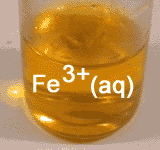 .
.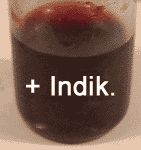 .
.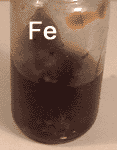 .
.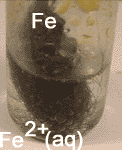
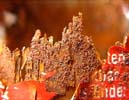 salt17
salt17
Coloured iron(III)
and iron(II) salts from a rusty Cola can

 Hydrochloric acid is corrosive! Use goggles, work in a trash, ask
an adult to join you.
Hydrochloric acid is corrosive! Use goggles, work in a trash, ask
an adult to join you.
"The overall reaction for
the corrosion of iron by oxygen (rusting)
is: 4 Fe(s) + 3 O2(g) --> 2 Fe2O3(s)" (S.S. Zumdahl). Beside Fe3+ions and oxide ions (O2-)
rust contains different quantities of bonded water molecules. So the salt may be black, yellow or "rust red".
Experiments:
Left: Add dopwise
1 ml of hydrochloric acid 20% to a piece of rusted Cola can.
* Observation Photo 2: A brown solution is obtained.
* Explanation: A chemical reaction takes place
Fe2O3
. nH2O(s)+ 6 HCl(aq) --> 2 Fe3+(aq)
+ 6 Cl-(aq) + n+3 H2O(l).
* Add a drop of ammonium thiocyanate
solution NH4(SCN) to test for iron(III) ions.
* Observation and Explanation Photo 3: A redbrown solution of the salt iron(III)
thiocyanate Fe(SCN)3 is formed.
* Add a small piece of steel
wool to this solution.
Observation
and Explanation Photo 4 + right: The redbrown colour of iron(III) thiocyanate Fe(SCN)3
disappears as the iron(III) ions reduced by the hydrogen formed by reaction
of steel wool and acid. The resulting iron(II) ions are not indicated by thiocyanate.
Re-building of the coloured iron salt at the air.
back............ go on.........first published:
25.10.2001.........................last modification: 25.03.2007
 .
. .
. .
. .
.
 .
. .
. .
. .
.
 salt17
salt17

 Hydrochloric acid is corrosive! Use goggles, work in a trash, ask
an adult to join you.
Hydrochloric acid is corrosive! Use goggles, work in a trash, ask
an adult to join you.